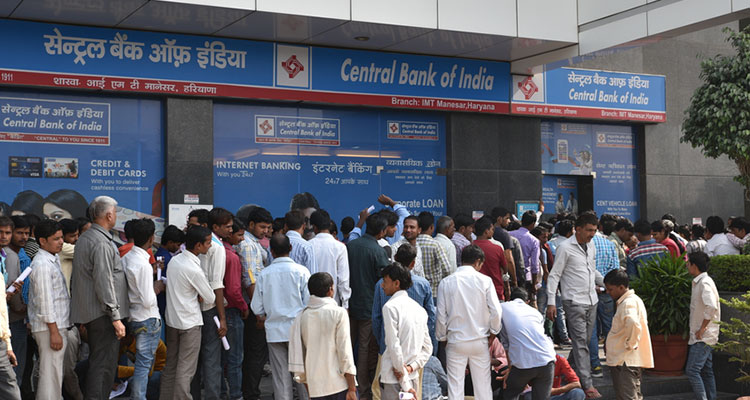Learning digital the hard way: India’s demonetization chaos
Catching citizens and banks by surprise, India recently discontinued the 500 and 1000 Rupee currency notes in its economy. The government reasons that the demonetization drive was essential to curb the black money and fake currency menace. Indian economy is largely slanted towards cash transactions, which constitute more than 90% of all transactions in rural India. As banks and ATMs run out of cash, people are losing patience. While the debate on whether the move will accomplish government’s said goals or not is still fresh, there is a need to focus on slightly tangential and more primal challenges in front of India’s economy.
Some experts believe that this move will prepare India for cashless transactions. This means that people would be expected to increase usage of e-wallets like Paytm and Ola-money. On the other hand, this will also reduce Cash on Delivery (CoD) transactions for e-commerce players. It may be noted that CoD is huge in India and is a big challenge for e-commerce players who have to bear costs for returns. Such transactions put extra pressure on supply chain and increase payments cycle for e-commerce vendors. Increase in amount of card payments can be a huge relief for the industry.
However, it is not as simple as it seems. India’s literacy levels (more than a third of population is still illiterate) and lack of low-level computer skills pose a huge challenge. A majority of population cannot be expected to make use of smartphones, online portals and e-wallets.
Further, World Economic Forum ranks India on 91st position on Networked Readiness Index; much behind its BRICS and Asian counterparts. While the situation is better in urban areas, rural areas lack basic infrastructure for high-speed connectivity. Overall, only 5.5 percent of the mobile users have mobile broadband and internet penetration is only 15% for Indian households. All this means that the relief for e-commerce players and e-wallet companies can only be momentary as the things are likely to get back to their default as soon as cash supply is normal.
The Silver Lining
The Indian government has ambitious digitization goals and has been generating a huge response with its “Digital India” initiative. 93% of adults or more than 100 crore people now have biometric-based Aadhaar cards, which are facilitating reduction of black money in the economy. The present government also launched 24 crore Jan Dhan bank accounts recently to improve Direct Benefit Transfers (DBT), which ensures credit subsidies directly into the account of beneficiaries, bypassing middlemen in the process. These steps have made a huge impact towards financial inclusion.
However, despite these laudable efforts, only a little over 50 percent of India’s population has access to banking services. Further, according to World Bank, India suffers from high dormancy rate of around 43 percent – which means that the bank accounts are lying idle.
Digitization of Banking Services
The infrastructural changes will take their time. Meanwhile, banks also need to gear up for the future. The answer lies in Digitization. Although it is too early to gauge the impact of demonetization on economic behavior and practices; emerging trends suggest that the things will be getting better by 2020. According to a Google-BCG report, digital payments industry in India will grow 10 times to $500 billion by 2020 and contribute 15% of GDP. Further, the report predicts that non-cash transactions will surpass cash transactions in the Indian economy by 2023. Yet another report from BCG says that about 315 million people in rural India (or 48% of the total online population) will be connected to the internet by 2020.
As the rural-urban divide becomes less prominent; there is a need to focus on solutions which are friendlier to the unique needs of rural India. Banking and Financial services working elsewhere around the globe cannot simply be replicated in the Indian environment. It is essential to get back to the basics, identify and accept all major challenges and then design solutions which meet the average user expectations in India.
The inspiration for these digital strategies can be drawn from the present. It is reported that social media and email accounts for 70% of internet usage in rural India. ICICI was perhaps the earliest to gauge this behavior when it allowed its users to do banking via Facebook.

Others can also replicate the same or at least draw some UX and UI learning from social websites to make banking websites and applications friendlier for a rural user. It doesn’t take too much to design a simpler App for smaller screens and low bandwidth telecom networks. The present home pages for most of the banking websites in India are too cluttered, rely on in-your-face advertising and confuse even a normal internet user.

Further local language support is a must to make such solutions work across India. As online commerce picks up, people’s trust and familiarity to card payments and e-wallets are likely to increase. Banks need to incentivize and market such cashless instruments.
While the private banks in India have taken an early lead in digital, public sector mammoth SBI is not far behind. The bank is undergoing a technology transformation and is closer to reducing its downtime to five times per year (near to global standards) from around 50 times per year three years ago. Moreover, one-fourth of SBI’s retail customers on web banking now also use its mobile banking option; a figure which the bank is eager to increase as mobile internet usage becomes more common and affordable for an average user.
Increasing the Investment Appetite
Reducing cash dependency for banking and payments is only one side of the coin. The bigger challenge is to increase the investment appetite and discourage cash-hoarding or jewelry buying habits. It’s a tough nut to crack. A majority of population isn’t comfortable parting its hard earned money with any risk-based investment instrument; they are happy with their savings accounts or fixed deposits. While aversion to risk is an acceptable factor; lack of awareness, misconceptions, and lack of user-friendly solutions is also responsible for this situation.
India holds huge potential for the financial sector to simplify the investment space for a common internet user. While there are portals like Policybazaar, helping users to compare and select mutual funds; it isn’t much of a help as there are too many options available. According to Sanjiv Singhal, founder, Scripbox an average investor is not equipped to take such decisions. There are more than 8000 mutual funds available in the market and without any solution helping a user with proper analytics; users are left to decide on hunches and friends’ advice. Scripbox is trying to make a difference by simplifying and automating mutual funds investment for users. It’s an early mover in the Indian financial investment space and there’s a lot of room for others to innovate and acquire.
Mobile based applications offer a simple avenue to increase investment awareness among the general population. Further, banks and NBFCs can innovate to create solutions that remove unwarranted fears and streamline investing for a common man.
The Bottom Line
Don’t ask a common man to discard cash – give him solutions as simple as using cash!
Credencys Solutions Inc is a leading software development services and solutions provider which have helped numerous businesses in building strategies for their business growth. Subscribe to our blogs for getting similar articles on management, strategy, leadership and more.








Comments are closed.